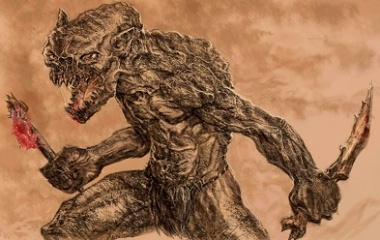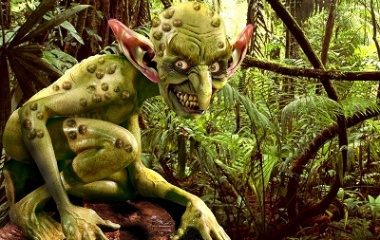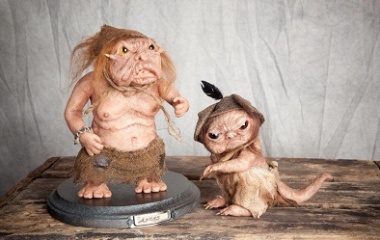Scattered across the most foreboding mountains and deep in the darkest mines, exist some of the most malicious, dangerous, and evil little creatures known to folklore, just waiting for an opportunity to steal your most precious belongings. The Goblin roams the Earth in a variety of different shapes and statures, and isn’t exactly what you would call a human’s best friend.
What is a Goblin?
A Goblin (alt. spellings: gobbelin, gobblin, goblyn, gobling, gobelin) is a mischievous, and usually very unpleasant, vengeful, and greedy creature whose primary purpose is to cause trouble to humankind; this is the most common type according to European folklore. There is a smaller population of Goblins, however, that possess a kinder, or more neutral temperament. Regardless of the type, though, all Goblins are rumored to hold various kinds of special abilities, often magical in nature. Some Goblins possess more fairy-like powers, similar to those of a witch or warlock; other types of Goblin have more demonic abilities, only using their magic to do harm.
Many people associate the Goblin with trolls, as they have an undesirable appearance and aren’t the most benevolent creatures. However, unlike trolls who are said to reside under bridges and in forests, the Goblin typically makes a home for itself in the mountains, just waiting for an opportunity (usually deep into the night) to snatch highly valued items such as gold and jewelry.
What Does a Goblin Look Like?
Different Types of Goblin
The appearance of a Goblin varies quite dramatically depending on its country of origin, although most types of Goblin are known for having quite unruly hair and green-colored skin. What many people don’t know is that there are actually 10 different types of Goblin; these types are often referred to as “sub-races” and each sub-race will typically have a distinct appearance and set of abilities. When most people think of a Goblin, what they’re imagining is usually the type known as a Trow or a Kobold. Trows have the ability to morph into human-like form; however, they are usually small in stature with an “ugly” appearance. Kobolds are more the stereotypical Goblin, with an appearance similar to the house-elf known as “Dobby” in the Harry Potter series.
Some of the more malevolent types tend to be known as hobgoblins. Hobgoblins are known for their dark, shaggy hair and are most closely related to the mythical creatures known as brownies; they don’t mean to cause harm and are widely known for their practical jokes. Hobgoblins also tend to have better relationships with humans. The “Knocker” is quite similar to the hobgoblin in both temperament and appearance; it makes its home in a mine and often befriends human mine workers so long as they stay on its good side. The Phooka is also similar to the hobgoblin in attitude, yet takes the form of a dark black horse. Another black, yet very small, sub-race of goblin is the Bogey; the Bogey is extremely difficult to kill due to its size.
The friendliest Goblin is known as the Hogboon; some say that it doesn’t even look (or act) like a Goblin at all! The Tengu is another sub-race which sometimes mimics the appearance of a dog-like Chinese demon, but more often takes the form of a bird. Tengus are respected by Buddhists as guardian spirits despite their demonic nature. The Kallikantzaro derives from Greek mythology and possesses a very long and lean appearance. Lastly, we have the Kol’ksu: a type of Goblin different from most others as it resides in the sea and resembles a mermaid. Unlike a mermaid, however, Kol’ksus are very dangerous and unkind.
The Origin of Goblins
Goblins originated in the 14th century and are most prevalent in northwestern Europe, Scandinavia, the British Isles, and the United States. The name “Goblin” is said to derive from the Old French spelling “gobelin”. However, it is also rumored to have German, Greek, and Latin roots with an overall negative connotation (“gobelinus” was the name of a devil or demon haunting the country of Normandy). Goblins were first popularized in tales from the Middle Ages.
Goblins in Contemporary Fiction:
We often see Goblins and their relatives portrayed in a variety of settings in many types of modern fiction, including movies, television shows and story books. Some of the most famous Goblin portrayals exist in films such as the Harry Potter series. In Harry Potter, these creatures are depicted as very stout, unattractive little monsters that run the famous wizard bank, Gringotts. Goblins also feature in a number of popular video and board/trading card games, such as Final Fantasy, Magic: the Gathering, Warcraft, and Runescape, among many others.
Related Creatures
Many mythical creatures resemble the appearance and nature of a Goblin. Just some of these creatures are elves, fairies, gremlins, ogres, trolls, and gnomes. Gnomes are similar to Goblins in a variety of ways, most noticeably in their appearance: small and stout, with pointy ears, and often a long matted beard. Many people know gnomes as the little ceramic statues that sit quietly in their garden – that is, until they mysteriously disappear. Gnomes, like Goblins, are known to be fond of playing tricks, and actually are rumored to reside in dwellings underground, similar to many types of Goblins.
Fairies are similar to Goblins, primarily with respect to their magical and mythical nature; fairies have special abilities, as do Goblins. Many people know Gremlins as the naughty, mischievous little creatures from the classic 1980s film written by Chris Columbus. Gremlins have a tendency to cause harm just for fun, specifically through dismantling machinery. Goblins are similar to Gremlins in that they’re also known for destroying things due to the pure fun of it. Elves, like Goblins, are often practical jokers and possess a similar appearance, most notably on account of their pointy ears. Ogres and trolls have many similarities to one another, but also have many of the same attributes as a Goblin: all are hideous, unkind, and like to cause trouble.











what color is a goblin because i dont think they are green at all
some are, but I agree you shouldn’t make the complete generalization.
My only criticism is…. Goblins are not ‘green’.
because GREEN IS NOT A CREATIVE COLOR!!!
need more information
this website is good
Best article ever.very interesting i mean i didn’t knew that there were 10 types of goblins
This article was a very good one.
That was a good article